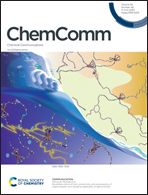Reversible control of ionic conductivity and viscoelasticity of organometallic ionic liquids by application of light and heat†
Abstract
Ru-containing ionic liquids [Ru(C5H5){C6H3(OC6H12CN)3}][N(SO2F)2] (1) and [Ru(C5H5){C6H5(OC3H6CN)}][N(SO2F)2] (2), having different numbers of substituents, were reversibly converted to coordination polymer solids and oligomeric liquids, respectively, by UV photoirradiation and heating. This feature enabled the control of their ionic conductivities and viscoelastic properties.



 Please wait while we load your content...
Please wait while we load your content...